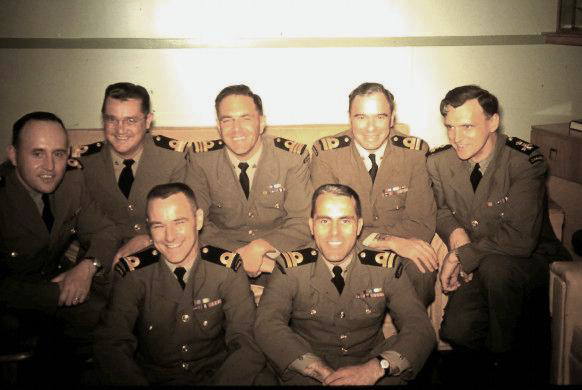 |
| Officers of Churchill 1956: Rear row (L-R) Kempton, Mason, Howard, Wilkinson, unidentified. Front row (L-R) Cy Walker and Larry Mann. (From the collection of D.S.K. Blackmore. Submitted by Donna Loewen). |
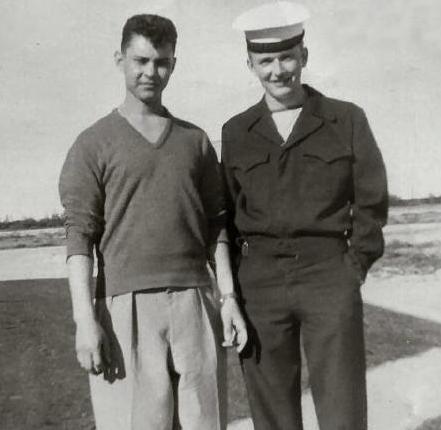 |
| 1961: Rick Flett (L) and David Smith at Churchill in 1961. David is wearing a '5B' jacket with bell-bottom trousers and a shirt that was referred to as a gunshirt (square-necked cotton T-shirt with a blue edge). In the 50's personnel seldom wore the gunshirt, but rather a plain white T-shirt. Also, the sailor cap was seldom worn. Instead, the blue winter cap referred to as an "Elmer Fudd" was worn. Rarely did anyone don the full sailor suit in the north. (Photo via David Smith) |
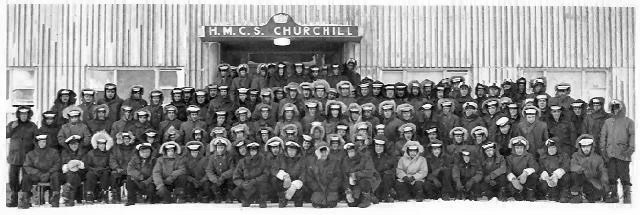 |
|
|
 |
| This photo shows the front entrance but a little further and back taken some 44 years later. The red outline denotes the same area as the 1957 photo. One can only imagine how busy this important base must have been during its heyday. (Photo by David Smith) |
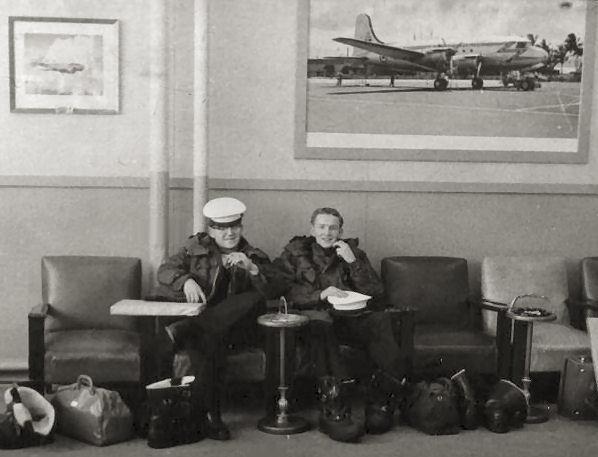 |
| 1961: (L-R) Gerry Tanner and David Smith waiting for a lift
to Alert in November 1961. Both are in full uniform which was required
anytime that personnel were on a military flight. The winter Arctic gear
supplied was impressive. Those Arctic boots were incredible - thick wool
linings and big enough so a person could slip them on over their boots
or shoes. The Arctic military issue jackets were equally functional
and with linings that could keep one toasty warm - even at the beastly
cold temperatures of Alert during the winter months.
Behind and above is a photo featuring the Canadair North Star, a very familiar aircraft in Canada's north. It was a unique Canadian redevelopment of the Douglas C-54/DC-4 (Photo and copy via David Smith) |
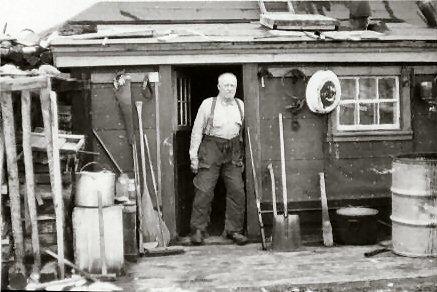 |
| Trapper Joe was a local character familiar to just about anyone
who served in Churchill in the 1950's and 60's. Ray White recalls meeting
him on several occasions. "He was located in a filthy shack that was his
castle at Goose Creek. We were on a fishing trip and for three days
we were the victims of the most voracious mosquitoes and black flies ever
seen on the face of the earth. We inadvertently spilled our water
supply and asked Trapper Joe for some, but when we saw the 45 gallon oil
drum he used for his water supply, we decided not to try it. We spent the
next couple of days drinking the juice from canned peaches."
David Smith remarks. "Life was a real challenge living out there on the tundra without running water or electricity or any of the creature comforts that we take for granted. He certainly appreciated the military bread the Churchill staff would provide for him". (Photo by David Smith) |
The following piece about Trapper Joe appeared in the Feb 1965 edition of Crowsnest Magazine.
SAILORS FRIEND DIES AT CHURCHILL
An old friend of naval personnel serving at HMCS Churchill, the naval
radio station in northern Manitoba,
Joseph K. (Trapper Joe) Chambers, died at Churchill on Dec. 6, 1964.
He was 83 years of age. Trapper Joe was born in Elora, Ont., where he attended
school and learned the cooper trade (which was the crafting of casks).
After several years of barrel making, he homesteaded in northwest Ontario,
but found he was more interested in hunting, fishing and trapping and agriculture.
He and a partner travelled by canoe to northern
Manitoba. The trapping venture was not a success and he served as a
deckhand until the First World War, when he went overseas with the 144th
Battalion, the Black Devils. After the war, he returned to trapping,
married and set up a trading post at Landing River on the uncompleted
Hudson Bay Railroad. When Churchill
was selected as the railway terminus, he moved to that area. He had
a trapping camp at Goose Creek, about 11 miles south of Churchill, until
his death. Just across the railway tracks from Trapper Joe's place, HMCS
Churchill
has had a recreational camp for many years and he frequently dropped
in to yarn by the hour with the sailors.
His funeral took place in Churchill on Dec. 6 and many of his Navy
friends were among the mourners present.
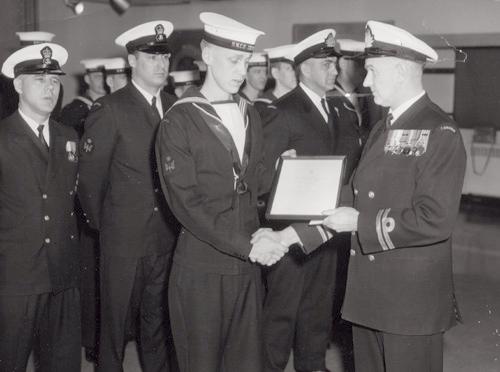 |
| Mid-late 1960's: A Hero's Award is presented by the base Commanding
Officer to Churchill matelot Bob Johnson for rescuing two people
from a burning house in Camp 20 Eskimo village adjacent to HMCS Churchill.
(L-R): Left to Right: P1 Sid Fowler, P1 Norm Armour, AB Bob Johnson - Our Hero, Cmd O George Fraser and LT Tug Wilson CO making presentation Sid Fowler was the P1 who, with members of the RCAF and the Army, unfurled and presented our new Canadian flag for the first time on Parliament hill. (RCN photo submitted by George Fraser) |
Contributors and Credits:
1) Fraser, George (caperfca@sympatico.ca)
2) Donna Loewen <donnaern(at)telus.net>
3) David Smith <drdee(at)sympatico.ca>